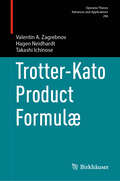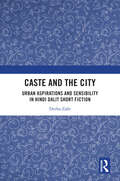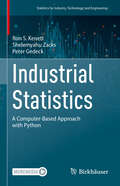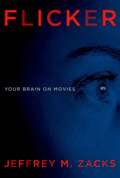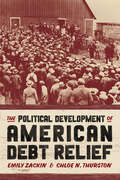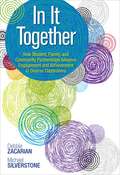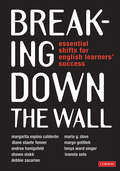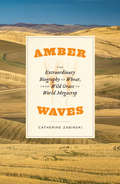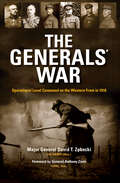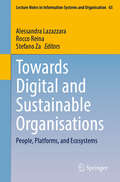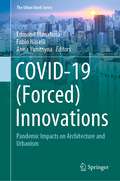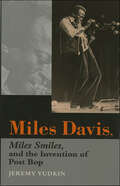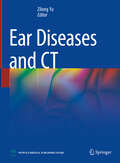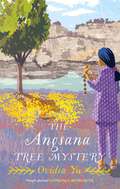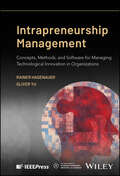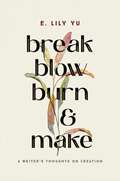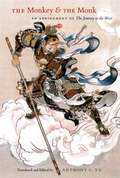- Table View
- List View
Trotter-Kato Product Formulæ (Operator Theory: Advances and Applications #296)
by Valentin A. Zagrebnov Hagen Neidhardt Takashi IchinoseThe book captures a fascinating snapshot of the current state of results about the operator-norm convergent Trotter-Kato Product Formulæ on Hilbert and Banach spaces. It also includes results on the operator-norm convergent product formulæ for solution operators of the non-autonomous Cauchy problems as well as similar results on the unitary and Zeno product formulæ.After the Sophus Lie product formula for matrices was established in 1875, it was generalised to Hilbert and Banach spaces for convergence in the strong operator topology by H. Trotter (1959) and then in an extended form by T. Kato (1978). In 1993 Dzh. L. Rogava discovered that convergence of the Trotter product formula takes place in the operator-norm topology. The latter is the main subject of this book, which is dedicated essentially to the operator-norm convergent Trotter-Kato Product Formulæ on Hilbert and Banach spaces, but also to related results on the time-dependent, unitary and Zeno product formulæ. The book yields a detailed up-to-date introduction into the subject that will appeal to any reader with a basic knowledge of functional analysis and operator theory. It also provides references to the rich literature and historical remarks.
Caste and the City: Urban Aspirations and Sensibility in Hindi Dalit Short Fiction
by Deeba ZafirThis book looks at Dalits in the city and examines the nature of Dalit aspirations as well as the making of an urban sensibility through an analysis of hitherto unexamined short stories of some of the first- and second-generation as well as contemporary Dalit writers in Hindi.Tracing the origins of the emergence of Dalit critical consciousness to the arrival of the Dalits into the print medium, after their migration to the city, this book examines their transactions with modernity and the emancipatory promises it held out to them. It highlights the literary tropes that mark their fiction, specifically those short stories which take up urban themes, and shows how even in seemingly caste-neutral spaces caste discrimination is present. The book also undertakes an examination of the stories by contemporary Dalit women writers in Hindi – Rajat Rani Meenu and Anita Bharti – who have posed a radical challenge to both the mainstream feminist movement and the Dalit movement.The volume will be of great interest to scholars and researchers of South Asian literature, especially Hindi literature, Dalit studies, subaltern history, postcolonial studies, political science, and sociology as well as the informed general reader.
Industrial Statistics: A Computer-Based Approach with Python (Statistics for Industry, Technology, and Engineering)
by Shelemyahu Zacks Ron S. Kenett Peter GedeckThis innovative textbook presents material for a course on industrial statistics that incorporates Python as a pedagogical and practical resource. Drawing on many years of teaching and conducting research in various applied and industrial settings, the authors have carefully tailored the text to provide an ideal balance of theory and practical applications. Numerous examples and case studies are incorporated throughout, and comprehensive Python applications are illustrated in detail. A custom Python package is available for download, allowing students to reproduce these examples and explore others.The first chapters of the text focus on the basic tools and principles of process control, methods of statistical process control (SPC), and multivariate SPC. Next, the authors explore the design and analysis of experiments, quality control and the Quality by Design approach, computer experiments, and cybermanufacturing and digital twins. The text then goes on to cover reliability analysis, accelerated life testing, and Bayesian reliability estimation and prediction. A final chapter considers sampling techniques and measures of inspection effectiveness. Each chapter includes exercises, data sets, and applications to supplement learning.Industrial Statistics: A Computer-Based Approach with Python is intended for a one- or two-semester advanced undergraduate or graduate course. In addition, it can be used in focused workshops combining theory, applications, and Python implementations. Researchers, practitioners, and data scientists will also find it to be a useful resource with the numerous applications and case studies that are included. A second, closely related textbook is titled Modern Statistics: A Computer-Based Approach with Python. It covers topics such as probability models and distribution functions, statistical inference and bootstrapping, time series analysis and predictions, and supervised and unsupervised learning. These texts can be used independently or for consecutive courses.This book is part of an impressive and extensive write up enterprise (roughly 1,000 pages!) which led to two books published by Birkhäuser. This book is on Industrial Statistics, an area in which the authors are recognized as major experts. The book combines classical methods (never to be forgotten!) and “hot topics” like cyber manufacturing, digital twins, A/B testing and Bayesian reliability. It is written in a very accessible style, focusing not only on HOW the methods are used, but also on WHY. In particular, the use of Python, throughout the book is highly appreciated. Python is probably the most important programming language used in modern analytics. The authors are warmly thanked for providing such a state-of-the-art book. It provides a comprehensive illustration of methods and examples based on the authors longstanding experience, and accessible code for learning and reusing in classrooms and on-site applicationsProfessor Fabrizio RuggeriResearch Director at the National Research Council, ItalyPresident of the International Society for Business and Industrial Statistics (ISBIS)Editor-in-Chief of Applied Stochastic Models in Business and Industry (ASMBI)
Flicker: Your Brain On Movies
by Jeffrey ZacksHow is it that a patch of flickering light on a wall can produce experiences that engage our imaginations and can feel totally real? From the vertigo of a skydive to the emotional charge of an unexpected victory or defeat, movies give us some of our most vivid experiences and most lasting memories. They reshape our emotions and worldviews--but why? In Flicker, Jeff Zacks delves into the history of cinema and the latest research to explain what happens between your ears when you sit down in the theatre and the lights go out. Some of the questions Flicker answers: Why do we flinch when Rocky takes a punch in Sylvester Stallone's movies, duck when the jet careens towards the tower in Airplane, and tap our toes to the dance numbers in Chicago or Moulin Rouge? Why do so many of us cry at the movies? What's the difference between remembering what happened in a movie and what happened in real life--and can we always tell the difference? To answer these questions and more, Flicker gives us an engaging, fast-paced look at what happens in your head when you watch a movie.
The Political Development of American Debt Relief
by Emily Zackin Chloe N. ThurstonA political history of the rise and fall of American debt relief. Americans have a long history with debt. They also have a long history of mobilizing for debt relief. Throughout the nineteenth century, indebted citizens demanded government protection from their financial burdens, challenging readings of the Constitution that exalted property rights at the expense of the vulnerable. Their appeals shaped the country’s periodic experiments with state debt relief and federal bankruptcy law, constituting a pre-industrial safety net. Yet, the twentieth century saw the erosion of debtor politics and the eventual retrenchment of bankruptcy protections. The Political Development of American Debt Relief traces how geographic, sectoral, and racial politics shaped debtor activism over time, enhancing our understanding of state-building, constitutionalism, and social policy.
In It Together: How Student, Family, and Community Partnerships Advance Engagement and Achievement in Diverse Classrooms
by Debbie Zacarian Michael A. SilverstoneHarness the power of teacher, student, school, family, and community partnerships to promote student success Teaching effectively in diverse classrooms has become more complex than ever. The authors of this practical, compelling, and inspiring book propose that understanding the spheres of influence that connect students with teachers, peers, family members, and the broader community significantly increases the odds that every student will succeed in school. In clear, practitioner-friendly language with examples from an inspiring range of K-12 educators, the authors explore how tapping into the rich resources of teachers, students, families, the school community and the community-at-large can make the work of learning more successful for all involved. Richly detailed vignettes and concrete, evidence-based strategies help you systematically: Build coalitions of support around learning and engagement Develop positive relationships with students, their families and their communities Foster positive, reciprocal partnerships Promote peer-to-peer relationship building Support students and families from marginalized populations Learn to draw from the rich resources found within your learning community to build bridges to academic success for all learners. This comprehensive book shows you how! "Building meaningful relationships in education can be difficult, particularly when the parties involved are different from one another in identity, experience, and other ways. As a result, although in principle collaborations and partnerships in education are universally lauded, in practice they are often ignored. What we need are examples of partnerships that work. In it Together by Debbie Zacarain and Michael Silverstone suggests productive ways to work with, learn from, and form authentic relationships with diverse communities. Combining their abundant experience in classrooms and schools, and using examples from caring teachers in diverse classrooms, the authors demonstrate what it means to really be "in it together." Teachers, administrators, and everyone who cares about the future of education in a diverse society will benefit from the strategies they suggest." —Sonia Nieto, Professor Emerita University of Massachusetts
In It Together: How Student, Family, and Community Partnerships Advance Engagement and Achievement in Diverse Classrooms
by Debbie Zacarian Michael A. SilverstoneHarness the power of teacher, student, school, family, and community partnerships to promote student success Teaching effectively in diverse classrooms has become more complex than ever. The authors of this practical, compelling, and inspiring book propose that understanding the spheres of influence that connect students with teachers, peers, family members, and the broader community significantly increases the odds that every student will succeed in school. In clear, practitioner-friendly language with examples from an inspiring range of K-12 educators, the authors explore how tapping into the rich resources of teachers, students, families, the school community and the community-at-large can make the work of learning more successful for all involved. Richly detailed vignettes and concrete, evidence-based strategies help you systematically: Build coalitions of support around learning and engagement Develop positive relationships with students, their families and their communities Foster positive, reciprocal partnerships Promote peer-to-peer relationship building Support students and families from marginalized populations Learn to draw from the rich resources found within your learning community to build bridges to academic success for all learners. This comprehensive book shows you how! "Building meaningful relationships in education can be difficult, particularly when the parties involved are different from one another in identity, experience, and other ways. As a result, although in principle collaborations and partnerships in education are universally lauded, in practice they are often ignored. What we need are examples of partnerships that work. In it Together by Debbie Zacarain and Michael Silverstone suggests productive ways to work with, learn from, and form authentic relationships with diverse communities. Combining their abundant experience in classrooms and schools, and using examples from caring teachers in diverse classrooms, the authors demonstrate what it means to really be "in it together." Teachers, administrators, and everyone who cares about the future of education in a diverse society will benefit from the strategies they suggest." —Sonia Nieto, Professor Emerita University of Massachusetts
Breaking Down the Wall: Essential Shifts for English Learners’ Success
by Debbie Zacarian Maria G. Dove Margarita Espino Calderon Diane Staehr Fenner Tonya W. Singer Margo Gottlieb Ivannia Soto Shawn M. Sinclair-Slakk Andrea HonigsfeldIt was a dark and stormy night in Santa Barbara. January 19, 2017. The next day’s inauguration drumroll played on the evening news. Huddled around a table were nine Corwin authors and their publisher, who together have devoted their careers to equity in education. They couldn’t change the weather, they couldn’t heal a fractured country, but they did have the power to put their collective wisdom about EL education upon the page to ensure our multilingual learners reach their highest potential. Proudly, we introduce you now to the fruit of that effort: Breaking Down the Wall: Essential Shifts for English Learners’ Success. In this first-of-a-kind collaboration, teachers and leaders, whether in small towns or large urban centers, finally have both the research and the practical strategies to take those first steps toward excellence in educating our culturally and linguistically diverse children. It’s a book to be celebrated because it means we can throw away the dark glasses of deficit-based approaches and see children who come to school speaking a different home language for what they really are: learners with tremendous assets. The authors’ contributions are arranged in nine chapters that become nine tenets for teachers and administrators to use as calls to actions in their own efforts to realize our English learners’ potential: 1. From Deficit-Based to Asset-Based 2. From Compliance to Excellence 3. From Watering Down to Challenging 4. From Isolation to Collaboration 5. From Silence to Conversation 6. From Language to Language, Literacy, and Content 7. From Assessment of Learning to Assessment for and as Learning 8. From Monolingualism to Multilingualism 9. From Nobody Cares to Everyone/Every Community Cares Read this book; the chapters speak to one another, a melodic echo of expertise, classroom vignettes, and steps to take. To shift the status quo is neither fast nor easy, but there is a clear process, and it’s laid out here in Breaking Down the Wall. To distill it into a single line would go something like this: if we can assume mutual ownership, if we can connect instruction to all children’s personal, social, cultural, and linguistic identities, then all students will achieve.
Breaking Down the Wall: Essential Shifts for English Learners’ Success
by Debbie Zacarian Maria G. Dove Margarita Espino Calderon Diane Staehr Fenner Tonya W. Singer Margo Gottlieb Ivannia Soto Shawn M. Sinclair-Slakk Andrea HonigsfeldIt was a dark and stormy night in Santa Barbara. January 19, 2017. The next day’s inauguration drumroll played on the evening news. Huddled around a table were nine Corwin authors and their publisher, who together have devoted their careers to equity in education. They couldn’t change the weather, they couldn’t heal a fractured country, but they did have the power to put their collective wisdom about EL education upon the page to ensure our multilingual learners reach their highest potential. Proudly, we introduce you now to the fruit of that effort: Breaking Down the Wall: Essential Shifts for English Learners’ Success. In this first-of-a-kind collaboration, teachers and leaders, whether in small towns or large urban centers, finally have both the research and the practical strategies to take those first steps toward excellence in educating our culturally and linguistically diverse children. It’s a book to be celebrated because it means we can throw away the dark glasses of deficit-based approaches and see children who come to school speaking a different home language for what they really are: learners with tremendous assets. The authors’ contributions are arranged in nine chapters that become nine tenets for teachers and administrators to use as calls to actions in their own efforts to realize our English learners’ potential: 1. From Deficit-Based to Asset-Based 2. From Compliance to Excellence 3. From Watering Down to Challenging 4. From Isolation to Collaboration 5. From Silence to Conversation 6. From Language to Language, Literacy, and Content 7. From Assessment of Learning to Assessment for and as Learning 8. From Monolingualism to Multilingualism 9. From Nobody Cares to Everyone/Every Community Cares Read this book; the chapters speak to one another, a melodic echo of expertise, classroom vignettes, and steps to take. To shift the status quo is neither fast nor easy, but there is a clear process, and it’s laid out here in Breaking Down the Wall. To distill it into a single line would go something like this: if we can assume mutual ownership, if we can connect instruction to all children’s personal, social, cultural, and linguistic identities, then all students will achieve.
Beyond Crises: Overcoming Linguistic and Cultural Inequities in Communities, Schools, and Classrooms
by Debbie Zacarian Margarita Espino Calderon Margo GottliebWhat are some lessons learned from the pandemic? We learned that, in times of crises, the humanitarian needs of students, families, and ourselves must be a top priority. We learned that forming effective partnerships with families and communities is essential to the health and well-being of our children. We were offered a blunt reminder that a system designed to serve the interests of a privileged few was destined to fail our historically underserved students, especially our millions of multilingual learners. Above all, we learned that the "normal" many of us have yearned for was never good enough—that we must envision a "better world," where we build on our multilingual students’ unique assets and cultivate their inner brilliance. Only then will we deliver on their promise. It’s this "better world," a world in which communities, schools, and classrooms work together as a "whole-child ecosystem," Beyond Crises: Overcoming Linguistic and Cultural Inequities in Communities, Schools, and Classrooms sets out to create. Taking a look from the outside in, Debbie Zacarian, Margarita Calderón, and Margo Gottlieb address three critical arenas: 1. Imagining Communities describes how to design and enact strengths-based family and community partnerships, including the critical importance of identifying, valuing, and acknowledging each member’s assets and competencies, and the ways recent crises have amplified their struggles. 2. Imagining Schools takes an up-close look at policies, structures, and now irrelevant ways of schooling that call for change and how we might reconfigure professional development to ensure every teacher and administrator is dedicated to the well-being and success of our multilingual learners. 3. Imagining Classrooms demonstrates how to optimize learning opportunities—both virtual and face-to-face—so our diverse students grow cognitively, linguistically, and social-emotionally, and accentuate their talents in knowing and using multiple languages in linguistically and culturally sustainable environments. "Student and family, classroom, school, and local community are not silos unto themselves," Debbie, Margarita, and Margo insist. "They are part of a larger whole that is interrelated and interconnected and, even, interdependent on each other. By forming stronger alliances, we can realize the power of truly working, socializing, and flourishing together." Beyond Crises is the first critical step forward.
Beyond Crises: Overcoming Linguistic and Cultural Inequities in Communities, Schools, and Classrooms
by Debbie Zacarian Margarita Espino Calderon Margo GottliebWhat are some lessons learned from the pandemic? We learned that, in times of crises, the humanitarian needs of students, families, and ourselves must be a top priority. We learned that forming effective partnerships with families and communities is essential to the health and well-being of our children. We were offered a blunt reminder that a system designed to serve the interests of a privileged few was destined to fail our historically underserved students, especially our millions of multilingual learners. Above all, we learned that the "normal" many of us have yearned for was never good enough—that we must envision a "better world," where we build on our multilingual students’ unique assets and cultivate their inner brilliance. Only then will we deliver on their promise. It’s this "better world," a world in which communities, schools, and classrooms work together as a "whole-child ecosystem," Beyond Crises: Overcoming Linguistic and Cultural Inequities in Communities, Schools, and Classrooms sets out to create. Taking a look from the outside in, Debbie Zacarian, Margarita Calderón, and Margo Gottlieb address three critical arenas: 1. Imagining Communities describes how to design and enact strengths-based family and community partnerships, including the critical importance of identifying, valuing, and acknowledging each member’s assets and competencies, and the ways recent crises have amplified their struggles. 2. Imagining Schools takes an up-close look at policies, structures, and now irrelevant ways of schooling that call for change and how we might reconfigure professional development to ensure every teacher and administrator is dedicated to the well-being and success of our multilingual learners. 3. Imagining Classrooms demonstrates how to optimize learning opportunities—both virtual and face-to-face—so our diverse students grow cognitively, linguistically, and social-emotionally, and accentuate their talents in knowing and using multiple languages in linguistically and culturally sustainable environments. "Student and family, classroom, school, and local community are not silos unto themselves," Debbie, Margarita, and Margo insist. "They are part of a larger whole that is interrelated and interconnected and, even, interdependent on each other. By forming stronger alliances, we can realize the power of truly working, socializing, and flourishing together." Beyond Crises is the first critical step forward.
Sustainable Business in the Era of Digital Transformation: Strategic and Entrepreneurial Perspectives (ISSN)
by Vesna Zabkar Marek Ćwiklicki Mariusz Sołtysik Magdalena Wojnarowska Maria Urbaniec Erica VareseSustainable development is a complex issue and despite many studies and publications in recent years, it remains poorly recognised on best practices in core business areas. Achieving the Sustainable Development Goals in accordance with the 2030 Agenda for Sustainable Development depends on research and innovation. Therefore, the transition to sustainable development requires investment in technology, new business models, and social and environmental innovations that contribute to shaping new business and promoting sustainable business practices.This book seeks to understand how sustainability affects core business areas, with a focus on strategic and entrepreneurial activities. Given these considerations, the main purpose of this book is twofold: (1) to contribute to a better understanding of important and current trends in the field of sustainable transformation in core business areas; and (2) to provide a comprehensive overview of quantitative and qualitative studies in the field. The book ultimately seeks to shed light on how companies are implementing sustainable transformation in the core areas of product and marketing, entrepreneurship, and innovation, which is supported by appropriate project management strategies.The book provides researchers and upper-level students in economics, business, and other social sciences with an overview of interdisciplinary theoretical and conceptual perspectives and frameworks for successful business transformation. It will be of particular value to those researching sustainable development and strategic management.
Amber Waves: The Extraordinary Biography of Wheat, from Wild Grass to World Megacrop
by Catherine ZabinskiA biography of a staple grain we often take for granted, exploring how wheat went from wild grass to a world-shaping crop. At breakfast tables and bakeries, we take for granted a grain that has made human civilization possible, a cereal whose humble origins belie its world-shaping power: wheat. Amber Waves tells the story of a group of grass species that first grew in scattered stands in the foothills of the Middle East until our ancestors discovered their value as a source of food. Over thousands of years, we moved their seeds to all but the polar regions of Earth, slowly cultivating what we now know as wheat, and in the process creating a world of cuisines that uses wheat seeds as a staple food. Wheat spread across the globe, but as ecologist Catherine Zabinski shows us, a biography of wheat is not only the story of how plants ensure their own success: from the earliest bread to the most mouthwatering pasta, it is also a story of human ingenuity in producing enough food for ourselves and our communities. Since the first harvest of the ancient grain, we have perfected our farming systems to grow massive quantities of food, producing one of our species’ global mega crops—but at a great cost to ecological systems. And despite our vast capacity to grow food, we face problems with undernourishment both close to home and around the world. Weaving together history, evolution, and ecology, Zabinski’s tale explores much more than the wild roots and rise of a now-ubiquitous grain: it illuminates our complex relationship with our crops, both how we have transformed the plant species we use as food, and how our society—our culture—has changed in response to the need to secure food sources. From the origins of agriculture to gluten sensitivities, from our first selection of the largest seeds from wheat’s wild progenitors to the sequencing of the wheat genome and genetic engineering, Amber Waves sheds new light on how we grow the food that sustains so much human life.
The Generals' War: Operational Level Command on the Western Front in 1918 (Twentieth-Century Battles)
by Major General David T. ZabeckiKnown as the War to End all Wars and the Great War, World War I introduced new forms of mass destruction and modern technological warfare. When the Bolsheviks pulled Russia out of the war in late 1917, the Germans turned their offensive efforts to the Western Front in an attempt to win the war in 1918. But as fresh American troops entered Europe, the strategic scales tipped against Germany.Much of how World War I played out turned on the plans and decisions of the senior-most German and Allied commanders. The Generals' War explores the military strategies of those generals during the last year of the Great War. These six very different men included Germany's Field Marshal Paul von Hindenburg and General Erich Ludendorff; France's Marshals Ferdinand Foch and Philippe Pétain; Great Britain's Field Marshal Sir Douglas Haig; and the United States' General John Pershing. Although history remembers none of them as great captains, these six officers determined for better or worse how World War I was fought on the battlefields of the Western Front between November 1917 and November 1918.The Generals' War is a landmark exploration of the generalship that shaped the very framework of modern warfare as we know it today and provides a comprehensive and detailed analysis on the senior commanders of the Great War.
Towards Digital and Sustainable Organisations: People, Platforms, and Ecosystems (Lecture Notes in Information Systems and Organisation #65)
by Stefano Za Alessandra Lazazzara Rocco ReinaThis book presents a collection of research papers that explore how ICT experts, managers, and policymakers can address sustainability issues in digital transformation (DT) by considering people practices, organizational processes, and platform design issues. Each chapter offers insights into how to create sustainable digital solutions that benefit both society and the environment. The diversity of views presented makes this book particularly relevant for scholars, companies, and public sector organizations. The content is based on revised versions of selected papers (original double-blind peer-reviewed contributions) presented at the annual conference of the Italian Chapter of AIS, which took place in Catanzaro, Italy, in October 2022.
COVID-19: Pandemic Impacts on Architecture and Urbanism (The Urban Book Series)
by Anna Yunitsyna Edmond Manahasa Fabio NaselliThis book gives an overview of the shifting paradigm from traditional design techniques and standards to new values and methods that occurred in response to confronting the COVID-19 pandemic. The theoretical studies of the phenomenon of "new normality" in architecture, urbanism and social sciences are a source of knowledge for researchers, professors and students in the fields of architecture, urbanism and interior design. On-site applications of post-COVID-19 structures will be interesting for students, practitioners, developers and city managers. The issue of online design teaching and learning provides a set of practices that can be applied by both educators and trainees. The book also is useful for readers who are interested in recent trends in architecture and interior design: it provides a deep analysis of recent changes in architecture, which aim to make the environment disease-free and the space habitable during the long periods of lockdown.
Four Fairies Tell Tales: Don't let the world confine you by defining who you should be
by Samson Yung-Abu“Disability has nothing on ability when ingenuity and agility is shield with a strong belief to achieve and a strong support to try.” In Four Fairies Tell Tales, classic fairy tales are reimagined with a fresh, inclusive twist for the modern age. Three beloved stories are retold, while one original tale makes its debut, each featuring a main character with a common mental or physical challenge. These characters embody bravery, strength, and mental agility, proving that having a ‘disability’ is not a drawback or weakness. Through their unique perspectives and ingenious problem-solving, the characters in these stories tackle challenges head-on, demonstrating that obstacles can be overcome regardless of one’s abilities. By representing and supporting the diverse culture of our modern age, Four Fairies Tell Tales aims to create a more inclusive society for all. This collection of stories celebrates the power of determination and resilience, reminding readers that a disability should never hold one back from achieving their goals and living life to the fullest.
Miles Davis, Miles Smiles, and the Invention of Post Bop
by Jeremy YudkinFocusing on one of the legendary musicians in jazz, this book examines Miles Davis's often overlooked music of the mid-1960s with a close examination of the evolution of a new style: post bop. Jeremy Yudkin traces Davis's life and work during a period when the trumpeter was struggling with personal and musical challenges only to emerge once again as the artistic leader of his generation.A major force in post-war American jazz, Miles Davis was a pioneer of cool jazz, hard bop, and modal jazz in a variety of small group formats. The formation in the mid-1960s of the Second Quintet with Wayne Shorter, Herbie Hancock, Ron Carter, and Tony Williams was vital to the invention of the new post bop style. Yudkin illustrates and precisely defines this style with an analysis of the 1966 classic Miles Smiles.
Ear Diseases and CT
by Zilong YuThis book consisted of 12 chapters, 280 color figures and 200 white & black figures; each figure was followed by a detail annotation.In the first part, the anatomy and surgical mark of the following structures were described respectively in detail: five portions of the temporal bone, external-media-internal ear, facial nerve in temporal bone, cerebellopontine angle and petrous apex. This is the basics of understanding the anatomic marks of normal radiological imaging and pathological-radiological imaging.In the second part, two-dimension CT imaging of temporal bone and the corresponding sectional anatomy of the same temporal bone were compared one by one on axial, coronal and sagittal view. Surgical and radiologic anatomic structures were marked in each section, their clinical significances were also explained in the meantime.In the third part, it covers 10 kinds of ear diseases using CT imaging in each part. It includes congenital malformation, trauma, inflammation, cholesteatoma. tumor and neighbor disease which affected the temporal bone, were described in detail respectively, some diseases attached MRI imaging and surgical findings. This may help for understanding radiological imaging and planning preoperative design.This book is useful for Otolaryngology & Head and Neck Surgery, Radiology doctors and related teaching personals.
The Angsana Tree Mystery (Su Lin Series #8)
by Ovidia Yu'One of Singapore's finest living authors' South China Morning Post 'Simply glorious. Every nook and cranny of 1930s Singapore is brought richly to life' CATRIONA MCPHERSON 'Charming' RHYS BOWEN 'One of the most likeable heroines in modern literature' SCOTSMAN ________________ The next book in the Mystery Tree series, exploring Singapore after the Japanese retreat and in the aftermath of WWII.Singapore 1949When all the angsana trees on the island bloom at the same time it's a glorious fragrant display that lasts only one day... and the next morning Su Lin comes across an old friend laughing hysterically while holding her dead lover on the thick carpet of yellow flowers by the quarry pool that was their childhood haunt. She instantly realises her friend could not be the killer as she could not have sliced so cleanly through the man's throat with no weapon in sight.As she tries to help her friend, Su Lin has to figure out where her own loyalties lie. Angsana blossoms aren't the only things disappearing overnight in post-war Singapore as the newly returned British-increasingly on edge because of anti-colonial uprisings in nearby Indonesia-rush to change laws and revoke permits and positions. But more pressingly, Su Lin has to prove her friend's innocence and stop a calculating killer from murdering again... ________________ Praise for Ovidia Yu: 'Chen Su Lin is a true gem. Her slyly witty voice and her admirable, sometimes heartbreaking, practicality make her the most beguiling narrator heroine I've met in a long while' Catriona McPherson 'Charming and fascinating with great authentic feel. Ovidia Yu's teenage Chinese sleuth gives us an insight into a very different culture and time. This book is exactly why I love historical novels' Rhys Bowen 'A wonderful detective novel . . . a book that introduces one of the most likeable heroines in modern literature and should be on everyone's Must Read list' Scotsman 'Unassuming, brilliantly observant' SCMP 'Ovidia Yu's writing helped me peel back the layers to understand Singapore. The story and Chen Su Lin's initiative and tenacity, set against a backdrop of wartime Singapore, intrigued both the historian and the mystery lover in me' Kara Owens CMG CVO, British High Commissioner to Singapore
The Angsana Tree Mystery (Su Lin Series #8)
by Ovidia Yu'One of Singapore's finest living authors' South China Morning Post 'Simply glorious. Every nook and cranny of 1930s Singapore is brought richly to life' CATRIONA MCPHERSON 'Charming' RHYS BOWEN 'One of the most likeable heroines in modern literature' SCOTSMAN ________________ The next book in the Mystery Tree series, exploring Singapore after the Japanese retreat and in the aftermath of WWII.Singapore 1949When all the angsana trees on the island bloom at the same time it's a glorious fragrant display that lasts only one day... and the next morning Su Lin comes across an old friend laughing hysterically while holding her dead lover on the thick carpet of yellow flowers by the quarry pool that was their childhood haunt. She instantly realises her friend could not be the killer as she could not have sliced so cleanly through the man's throat with no weapon in sight.As she tries to help her friend, Su Lin has to figure out where her own loyalties lie. Angsana blossoms aren't the only things disappearing overnight in post-war Singapore as the newly returned British-increasingly on edge because of anti-colonial uprisings in nearby Indonesia-rush to change laws and revoke permits and positions. But more pressingly, Su Lin has to prove her friend's innocence and stop a calculating killer from murdering again... ________________ Praise for Ovidia Yu: 'Chen Su Lin is a true gem. Her slyly witty voice and her admirable, sometimes heartbreaking, practicality make her the most beguiling narrator heroine I've met in a long while' Catriona McPherson 'Charming and fascinating with great authentic feel. Ovidia Yu's teenage Chinese sleuth gives us an insight into a very different culture and time. This book is exactly why I love historical novels' Rhys Bowen 'A wonderful detective novel . . . a book that introduces one of the most likeable heroines in modern literature and should be on everyone's Must Read list' Scotsman 'Unassuming, brilliantly observant' SCMP 'Ovidia Yu's writing helped me peel back the layers to understand Singapore. The story and Chen Su Lin's initiative and tenacity, set against a backdrop of wartime Singapore, intrigued both the historian and the mystery lover in me' Kara Owens CMG CVO, British High Commissioner to Singapore
Intrapreneurship Management: Concepts, Methods, and Software for Managing Technological Innovation in Organizations (IEEE Press Series on Technology Management, Innovation, and Leadership)
by Oliver Yu Rainer HasenauerDevelop and deploy industry-leading ideas with this groundbreaking management toolkit The universal modern image of an innovator is a technological entrepreneur, who conceives and develops their groundbreaking ideas outside an existing institution and only subsequently builds infrastructure around it. In reality, however, the bulk of technological innovation comes through Intrapreneurship: innovation that takes place inside an existing organization, taking advantage of the institutional support and economies of scale provided by continuing enterprises. Intrapreneurship Management is an approach that cultivates these internal innovations and the knowledge workers who produce them. Intrapreneurship Management: Concepts, Methods, and Software for Managing Technological Innovation in Organizations offers a guide to this approach, its challenges, and its rewards. Beginning with a simple yet flexible definition of innovation—an idea implemented with impact—it analyzes the processes and organizational tools by which novel ideas can be fostered, supported, and applied, producing industry-leading firms that maximize their internal talent. It also provides access and tools for using IntrapreneurshipREADINESSNavigator (IRN), a unique software already deployed successfully in over 150 innovation projects. Intrapreneurship Management readers will also find: Case studies of technological innovations within a range of organizations A look forward to future challenges facing innovative organizations in the 21st century Detailed treatment of subjects including innovation marketing, systematic creativity, and developing innovative organizational culture Intrapreneurship Management is ideal for intrapreneurs, their managers, and any professionals working in industries driven by technological innovation, as well as researchers and students of management.
Break, Blow, Burn, and Make: A Writer's Thoughts on Creation
by E. Lily YuFrom the award-winning author of On Fragile Waves comes an inspirational, surprising guide to creation and creativity, and how both bring us closer to God. Centuries ago, sound theology and good fiction were friends and not strangers. Decades ago, authors strove not for self-expression and self-disclosure but for a mastery of craft and language and books that transformed the reader with wisdom and love. In more recent years, the old ideals have been exchanged for lesser ones. Few guides to writing, which tend to focus on mechanics, point of view, and plot, address the more important matters of meaning, depth, and heart. But it is the latter qualities that make a book a blessing and gift to both writer and reader. Like Christ&’s invitation to follow, they demand a risk and sacrifice of the self and all it holds dear. Writers from George MacDonald to James Baldwin understood this, but in recent years this understanding has been lost. Making old things new, this book proposes an ethics of reading, writing, and living based on truth and love. Break, Blow, Burn, & Make returns the literary conversation to the practices of co-creation with God. Part bugle call, part compass for writing and for life, and part love song to the books that set us on fire, it offers those who are willing to receive it the courage to live, read, and write more deeply and honestly.
The Monkey and the Monk: An Abridgment of The Journey to the West (Women In Culture And Society Ser.)
by Anthony C. YuAnthony C. Yu’s celebrated translation of The Journey to the West reinvigorated one of Chinese literature’s most beloved classics for English-speaking audiences when it first appeared thirty years ago. Yu’s abridgment of his four-volume translation, The Monkey and the Monk, finally distills the epic novel’s most exciting and meaningful episodes without taking anything away from their true spirit. These fantastic episodes recount the adventures of Xuanzang, a seventh-century monk who became one of China’s most illustrious religious heroes after traveling for sixteen years in search of Buddhist scriptures. Powerfully combining religious allegory with humor, fantasy, and satire, accounts of Xuanzang’s journey were passed down for a millennium before culminating in the sixteenth century with The Journey to the West. Now, readers of The Monkey and the Monk can experience the full force of his lengthy quest as he travels to India with four animal disciples, most significant among them a guardian-monkey known as “the Great Sage, Equal to Heaven.” Moreover, in its newly streamlined form, this acclaimed translation of a seminal work of world literature is sure to attract an entirely new following of students and fans. “A new translation of a major literary text which totally supersedes the best existing version. . . . It establishes beyond contention the position of The Journey to the West in world literature, while at the same time throwing open wide the doors to interpretive study on the part of the English audience.”—Modern Language Notes, on the unabridged translation
Saving Christianity?: The Danger In Undermining Our Faith -- And What You Can Do About It
by Michael YoussefA clear and frank exploration of the future of Christianity and whether it needs to be saved. We live in confusing times. Our society has shifted on its moral axis, and many are asking whether Christianity needs to be reinvented—or even reimagined—in order to save it. With Newsweek declaring “The Decline and Fall of Christian America” on its cover and The Daily Beast questioning “Does Christianity Have a Future?” bloggers and Christian commentators are discussing whether we need a “new of kind of Christianity.”In Saving Christianity? Dr. Michael Youssef explores this train of thought and its pitfalls. He describes how similar discussions in Christianity’s recent past explored the very same question. Saving Christianity? will help you discern what is going on within the church while it reviews the essentials of the Christian faith as described in the Bible. We dare not abandon this “mere faith,” as Dr. Youssef describes it, because it is the light for all humanity—and especially for those of us living in today’s chaotic times. After reading Saving Christianity? you’ll have a renewed confidence in the future of the church and the central place it will occupy for generations to come.
